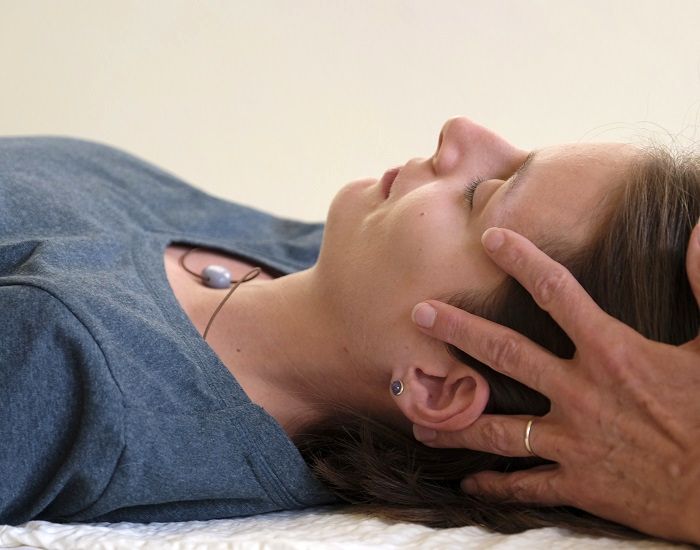Training biodynamic craniosacral therapy level 6 incl. repetition day 5
The facial skull, conception, fallopian tube journey and the process of implantation and the psychology of the mask: Identity and Identification, Facial Diagnosis and its reflection in the Spheno-Basilar JointCourse contents
This level of training continues with the embryological origins of life. Humans develop in a fluid medium within membranes. During embryological development, these flows also give rise to major parts of the head and face. We study these developmental dynamics and how they are felt in the now in a human being. Structurally, this includes detailed work on the face, jaw bones, vomer (ploughshare bone), ethmoid (ethmoid bone), teeth, and other intraoral structures. We learn a playful yet accurate form of facial diagnosis that allows us to draw conclusions about patterns and lesions in the spheno-basilar joint, which often originate in the dynamics of birth. We look at how the face reflects prenatal experiences, particularly the process of implantation of the conceptus (the early embryo) into the mucosa of the uterus, around day 6 of human embryological development.Beyond the physical experience, this experience can express something about our relationship to the world and to others. This experience can create a fundamental sound that can influence our whole life in many complex ways. Here we consider the psychological concept of the mask and the persona according to C.G. Jung in continuation of the idea of the body-ego. In this context we also hear a bit the concept of identity and identification. We delve into how using appropriate language can help integrate emotional processes in the here and now.
In embryological development, there is a special relationship between the heart and the face. They develop together for a long time and have a special connection in the adult body as well. Many aspects of our social nervous system (PORGES) are involved and this connection also plays a special role in the stress regulation of the human body and in the way we enter into human relationships.
Participants will deepen their knowledge of human embryological development. In the context, we consider the importance of the nidation experience of the embryo and how it is reflected in particular in the face of the adult human.
- The dynamics of some midline bones, especially in the skull and face
- The model of the mask according to C. G. Jung
- Phenomenological view of nidation and implantation (implantation of the embryo)
- The embryonic development of the facial skull (viscerocranium)
- Structural relationship between viscerocranium, the hard palate and the spheno-basilar joint
Facial diagnosis and the patterns of the spheno-basilar joint - The relationship of the face to prenatal human development
- Healing, goal- and resource-oriented language
- The special relationship of the face to the heart in embryological consideration
- The heart as an essential regulator in stress processing
- Hypnosystemic order clarification
Course objectives
The participants- Know the dynamics of the midline bones in the Craniosacral Concept
- Experience the dynamics of the midline bones in touch and are able to offer treatment in practice
- Are able to describe the nidation/implantation phenomenologically
- Know the journey of the conceptus through the fallopian tube and the process of implantation (implantation)
- Recognize the importance of implantation to the development of the face and also some of the possible psychological effects of this experience
- Are able to apply knowledge of the embryological development of the facial skull, viscerocranium (as opposed to neurocranium) and hard palate to practical work
- Know the psychological concept of the mask and persona according to C. G. Jung and recognize how appropriate language can integrate emotional processes in the here and now
- Deepen linguistic skills in accompanying clients
- Have knowledge of an accurate facial diagnosis and the most common patterns of the sphenobasilar joint: flexion, extension, torsion, lateral tilt, lateral and vertical displacements, compression
- Practice and apply this facial diagnosis
- Know aspects of the hypnosystemic concept useful for craniosacral therapy and use them in the therapeutic process. Clarification of the order
Target group
Participants of the biodynamic craniosacral training of the School for Craniosacral Therapy Kiental.Remarks
40 hours of training, EMR/ASCA compliant.We reserve the right to change the teaching team in special situations.
Course costs
CHF 1280 (excl. accommodation, meals and tourist tax)
CHF 1150 (excl. accommodation, meals and tourist tax). The early bird price is only applicable for a down payment of 20% 14 days after registration and payment of the remaining costs up to 60 days before the seminar begins. Please note sections 8, 20 and 21 of the terms and conditions.
Personal advice

Elsa Sousa
Main Number: +41 33 676 26 76 | Direct Number: +41 33 676 76 25 | E-Mail: elsa.sousa@kientalerhof.ch
